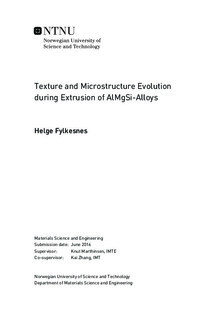Texture and Microstructure Evolution during Extrusion of AlMgSi-Alloys
Master thesis
Permanent lenke
http://hdl.handle.net/11250/2406967Utgivelsesdato
2016Metadata
Vis full innførselSamlinger
Sammendrag
The main objective of this thesis is to contribute to a better understanding of the microstructure and texture evolution during extrusion of AlMgSi alloys.
The textures and microstructures in AA6082 were analysed after extrusion into a flat profile, after extrusion into a cylindrical rod, after subsequent cold rolling of the extruded rod material and after annealing of the rolled material. The textures and microstructures of AA6060 were analysed after extrusion of a cylindrical rod, after subsequent cold rolling and after annealing of the rolled material. The microstructures and textures of these samples was investigated by EBSD in a SEM and by XRD. The AA6060 extruded round fibre had a recrystallised microstructure where the texture consisted of 100 -fibre coupled with a random texture. AA6082 extruded rod contains dispersoids which hinders recrystallisation. Thus the microstructure is a non-recrystallised microstructure consisting of 0.5 100-fibre and 0.43 111-fibre.
Texture simulations were mainly carried out using VPSC. The parameters varied in these simulation were slip planes activated durin deformation, strain rate sensitivity and interaction scheme. The deformation modes used during the simulations were uni-axial tensile deformation (Carried out using a random texture as input texture) and plane strain deformation (Carried out using 100-fibre and 111-fibre as input texture). Texture simulation were also done using ALAMEL model (and modifications of it). These simulations were carried out using the same deformations coupled with the same input textures as the VPSC simulations. These simulations were partly done to find what effect the different simulation parameters have on the end texture. They were also done to find how one can get the textures observed experimentally in aluminium.
The main findings were that inclusion of the 112 110 slip system in texture simulations gives a texture closer to the experimental observed texture when the deformation mode where uniaxial deformation. It was not posible to find simulations parameters, using strain rate deformation, which gave texture close to the experimental observed texture.
